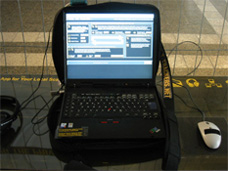I've blogged, seen and talked about many artistic projects that remind us of the omnipresence of technologies of control --and in particular surveillance cameras-- in public space. And grown increasingly sceptical. The audience of such art works usually "knows", right? Most of them are already very critical of the big brotherization of our society. It sometimes feels like preaching to the converted. What about the others? Those who don't go to the ars electronica of the world or feel safer when they are video'd on CCTV, can they really be shaken by these artistic and activist projects? Is "trying to rise awareness" enough? I was thinking again about those questions today while travelling, arrived in Turin and stumbled upon an article on BBC news where Bill Thompson discusses an upcoming session at the ENTER_ conference that will take place in Cambridge at the end of the month. One of the projects presented is (re)collector, by James Coupe.

The installation uses footage from CCTV in Cambridge to extract daily storyline narratives, and make up larger computer generated feature films
Surveillance cameras were programmed to recognise and capture public activities including farewell scenes, meetings, escape scenes, chases, love scenes, etc. Each day over the festival, the results will be edited to produce a daily feature film, rather than a documentary, showing just how much variety, interest and excitement can be reflected in everyday lives. The daily films will be organised to have a premise, protagonists, locations, plot, etc. to be viewed at a public screening in Cambridge during the festival programme. Interesting, not as powerful as the Surveillance Camera Players but i'd love to see what comes out of it. Would innocent passersby be disturbed (or just amused) to discover that their most banal activities can be material for a soap CCTV opera?
I was about to leave the story as a del.icio.us link but 3 seconds after read about another surveillance project on plus six.
Tracking-the-trackers is a mobile unit that provides participants with an expanded audible experience of the proliferation of video surveillance in urban space. A bag contains a laptop, GPS-receiver, earphones, and a mouse is taken on a walk through the city. The sound in the headphones changes whenever the participant enters the vicinity of a surveillance camera. This effect is not automatic but created by other participants who are continuously adding new locations to the existing database.

![]()
Track-the-trackers got all my attention because the technology used in the piece is documented with precise instructions to allow others to build similar systems and improve on the design. Apparently the last time they carried out the experiment was in 2004. Too bad... I might be sceptical but i still want to believe that artistic projects do matter.

